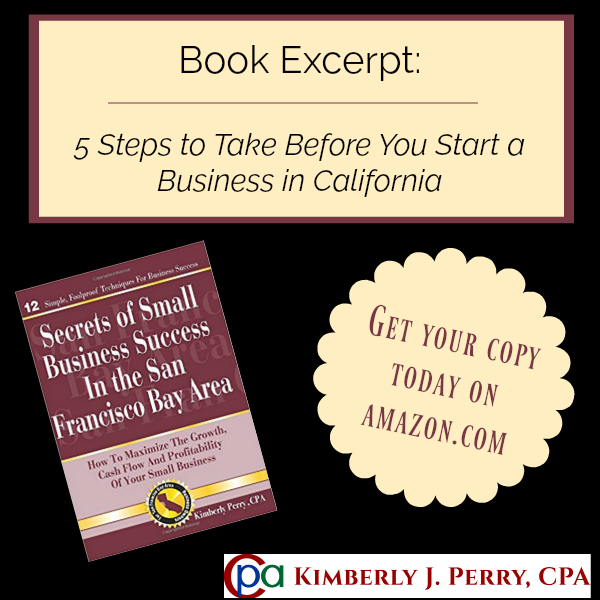5 Steps to Take Before You Start a Business in California – January 30, 2018
 There are a number of different reasons for starting a business. Perhaps you are interested in “trying something new.” Perhaps you have found a new way to solve a problem or meet an expressed need, maybe you want independence, or are trying to increase your income.
There are a number of different reasons for starting a business. Perhaps you are interested in “trying something new.” Perhaps you have found a new way to solve a problem or meet an expressed need, maybe you want independence, or are trying to increase your income.
Whatever your reasons for going into business, you must do so with your eyes wide open. If you are like most people, it’s likely you haven’t thought as much about the downside of going into business as you have about the bright side. A great deal of thought and research should go into making a decision that will affect you and your family for a long time to come.
Step 1: Evaluating your personal strengths
Evaluating your personal strengths and weaknesses as the owner and manager of a small business is a good place to begin. Carefully consider each of the following questions.
- Are you a “self-starter?”
- How well do you get along with different types of personalities?
- How are you at making decisions?
- Do you have the physical and emotional stamina to run a business?
- How well do you plan and organize? Are you a planner?
- Is your drive strong enough to maintain your motivation?
- How will the business affect your family?
If you are serious about going ahead and starting your own business, there are important steps you should go through before you go too far along the line.
Step 2: Deciding the right business to choose
You may already have a very good idea of the business you will choose and feel like you can skip this step. Don’t. It always helps to test and refine your idea. You can do this very easily. Brainstorm all the businesses you could reasonably consider, write them down, and then eliminate those that you know are not for you.
Rule out the ones that require talents and skills you do not possess, and of course those in which you have no interest. Then, gather information and evaluate your idea against other possibilities.
After collecting this additional information and reconsidering your list, narrow the possibilities. Get advice. One of the common errors in choosing a business is not asking for help. This is an important way to gather information to complete the selection process. There are four things you can actively do:
- Talk with people who own and operate similar businesses
- Work for someone else for a while
- Ask for professional advice
- Share your thoughts with your family, friends and associates
Step 3: Is your idea feasible?
Once you’ve narrowed down and refined your idea, you need to decide if this business will be successful.
Before you run to the bank, get a loan, and open your business, take the time to figure out if your business will have a chance to succeed.
A common mistake many new business owners make is to blindly begin a business without evaluating its feasibility. Doing so will allow you to make a more informed “go” or “no go” decision. A sampling of topics that should be honestly appraised includes:
- Have you researched market demand or have you just assumed that people need or want your product or service?
- Will your product or service serve an existing market in which demand exceeds supply?
- Will your product or service be competitive based on its quality, selection, price or location?
- Do you know who your customers will be?
- Do you understand how your business compares with your competitors?
Your business must meet the needs and desires of buyers, and do so effectively and efficiently. How do you know? The answer is simple – analyze the market.
This research should not be neglected nor should it be the sole source of information used in developing a business or marketing plan.
Step 4: Will you be able to meet the needs of the market place?
Once you determine that your idea is indeed feasible, it’s time to decide if you are going to be able to fulfill the needs of your market. Conducting what is called a “SWOT” analysis is an ideal method for describing your ability to construct a business that has the potential to meet customer needs and, ultimately, be successful.
In a SWOT Analysis, you essentially nominate the Strengths and Weaknesses of the business (its internal resources and capabilities), and then you identify the Opportunities and Threats it faces (factors external to the organization).
This is an easy, understandable way of identifying key issues and communicating them to others.
Step 5: Find a knowledgeable accountant.
Congratulations! If you’ve completed the first four steps, you are on your way to putting together your Business Plan, an important cornerstone of starting a business. But there are still many more questions to answer and choices to make.
At this point I recommend you make an appointment with a knowledgeable accountant.
He or she can review your information, answer your questions, and point you in the right direction to complete the additional steps needed to start your business.
For more on this topic, please check out my book “Secrets of Small Business Success in the San Francisco Bay Area“.